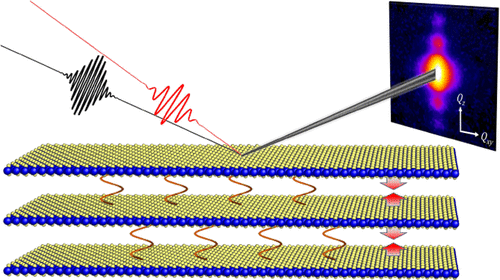当前位置:
X-MOL 学术
›
Nano Lett.
›
论文详情
Our official English website, www.x-mol.net, welcomes your
feedback! (Note: you will need to create a separate account there.)
Dynamic Optical Tuning of Interlayer Interactions in the Transition Metal Dichalcogenides
Nano Letters ( IF 9.6 ) Pub Date : 2017-11-15 00:00:00 , DOI: 10.1021/acs.nanolett.7b03955 Ehren M. Mannebach 1 , Clara Nyby 2 , Friederike Ernst 3, 4 , Yao Zhou 1 , John Tolsma 5 , Yao Li 3 , Meng-Ju Sher 6, 7 , I-Cheng Tung 8 , Hua Zhou 8 , Qi Zhang 8 , Kyle L. Seyler 9 , Genevieve Clark 9 , Yu Lin 6, 10 , Diling Zhu 11 , James M. Glownia 11 , Michael E. Kozina 3, 6 , Sanghoon Song 11 , Silke Nelson 11 , Apurva Mehta 11 , Yifei Yu 12 , Anupum Pant 13 , Ozgur Burak Aslan 3 , Archana Raja 3, 4 , Yinsheng Guo 14 , Anthony DiChiara 8 , Wendy Mao 4, 6, 10 , Linyou Cao 12 , Sefaattin Tongay 13 , Jifeng Sun 15 , David J. Singh 15 , Tony F. Heinz 3, 4, 6 , Xiaodong Xu 9 , Allan H. MacDonald 5 , Evan Reed 1, 4 , Haidan Wen 8 , Aaron M. Lindenberg 1, 4, 6
Nano Letters ( IF 9.6 ) Pub Date : 2017-11-15 00:00:00 , DOI: 10.1021/acs.nanolett.7b03955 Ehren M. Mannebach 1 , Clara Nyby 2 , Friederike Ernst 3, 4 , Yao Zhou 1 , John Tolsma 5 , Yao Li 3 , Meng-Ju Sher 6, 7 , I-Cheng Tung 8 , Hua Zhou 8 , Qi Zhang 8 , Kyle L. Seyler 9 , Genevieve Clark 9 , Yu Lin 6, 10 , Diling Zhu 11 , James M. Glownia 11 , Michael E. Kozina 3, 6 , Sanghoon Song 11 , Silke Nelson 11 , Apurva Mehta 11 , Yifei Yu 12 , Anupum Pant 13 , Ozgur Burak Aslan 3 , Archana Raja 3, 4 , Yinsheng Guo 14 , Anthony DiChiara 8 , Wendy Mao 4, 6, 10 , Linyou Cao 12 , Sefaattin Tongay 13 , Jifeng Sun 15 , David J. Singh 15 , Tony F. Heinz 3, 4, 6 , Xiaodong Xu 9 , Allan H. MacDonald 5 , Evan Reed 1, 4 , Haidan Wen 8 , Aaron M. Lindenberg 1, 4, 6
Affiliation

|
Modulation of weak interlayer interactions between quasi-two-dimensional atomic planes in the transition metal dichalcogenides (TMDCs) provides avenues for tuning their functional properties. Here we show that above-gap optical excitation in the TMDCs leads to an unexpected large-amplitude, ultrafast compressive force between the two-dimensional layers, as probed by in situ measurements of the atomic layer spacing at femtosecond time resolution. We show that this compressive response arises from a dynamic modulation of the interlayer van der Waals interaction and that this represents the dominant light-induced stress at low excitation densities. A simple analytic model predicts the magnitude and carrier density dependence of the measured strains. This work establishes a new method for dynamic, nonequilibrium tuning of correlation-driven dispersive interactions and of the optomechanical functionality of TMDC quasi-two-dimensional materials.
中文翻译:

过渡金属二硫属元素化物中层间相互作用的动态光学调谐。
过渡金属二卤化物(TMDC)中准二维原子平面之间的弱层间相互作用的调制提供了调节其功能性质的途径。在这里,我们显示,TMDC中的间隙上方光学激发会导致二维层之间出现意想不到的大振幅,超快压缩力,这是通过在飞秒时间分辨率下原子层间距的原位测量来探测的。我们表明,这种压缩响应是由层间范德华相互作用的动态调制引起的,并且这代表了在低激发密度下主要的光诱导应力。一个简单的分析模型可以预测所测应变的大小和载流子密度的依赖性。这项工作建立了一种新的动态方法,
更新日期:2017-11-15
中文翻译:

过渡金属二硫属元素化物中层间相互作用的动态光学调谐。
过渡金属二卤化物(TMDC)中准二维原子平面之间的弱层间相互作用的调制提供了调节其功能性质的途径。在这里,我们显示,TMDC中的间隙上方光学激发会导致二维层之间出现意想不到的大振幅,超快压缩力,这是通过在飞秒时间分辨率下原子层间距的原位测量来探测的。我们表明,这种压缩响应是由层间范德华相互作用的动态调制引起的,并且这代表了在低激发密度下主要的光诱导应力。一个简单的分析模型可以预测所测应变的大小和载流子密度的依赖性。这项工作建立了一种新的动态方法,











































 京公网安备 11010802027423号
京公网安备 11010802027423号